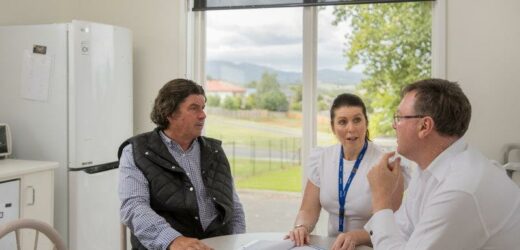Neerim’s hospital overlooks a sweeping valley of lush paddocks and new houses that have sprung up on pastures where cows once grazed.
Neerim District Health Service is one of the last services in Victoria that was set up as a bush nursing hospital and still remains community owned.
Cataract surgery at the Neerim District Health Service which delivers thousands of eye surgeries a year. Credit:Simon Schluter
In decades gone by, bush nursing hospitals lay at the heart of their communities. Residents typically raised funds to build them and took out memberships that provided voting rights on major decisions at annual general meetings.
Victoria once had more than 60 bush nursing hospitals, but over the years most of them succumbed to financial pressure. Some were swallowed up by private health or aged care providers.
Now those still operating rely on op-shops, aged care wings and donations to help them survive.
Neerim District Health Service chairman Sean Dignum insisted the surrounding community still loves the hospital, which conducts thousands of eye surgeries a year, dental and endoscopy procedures, as well as stabilisation treatment in emergencies until an ambulance or helicopter arrives.
Neerim District Health Service chief executive Graham Bailey, clinical services director Bernie McKenna and board chair Sean Dignum. Credit:Simon Schluter
It also operates an aged care facility and community services.
Mr Dignum said some locals even dipped into their pockets to share whatever they could with the hospital, including one elderly, anonymous man who slapped down a wad of about $4000 in cash on the front counter last year.
Former nurse Shirley Le Page now volunteers at the Neerim District Health Service where she worked as a nurse of 44 years. Credit:Simon Schluter
While it received state government grants last year, Mr Dignum said the hospital had to rely on donations and bequests to remain afloat because it did not receive recurrent government funding.
“We’ve been using [donations] for the last few years to keep going on operational costs,” he said. “That shouldn’t be the case.”
Last year, it delivered an operating loss of $143,000.
But with a rising population in Neerim South, which lies just beyond Melbourne’s south-eastern fringe, demand for local healthcare is rising.
Census data from 2016 put Neerim South’s population at 1300, but Mr Dignum said the service had a catchment of 30,000 people.
The operating theatre runs at full capacity over six days a week, delivering procedures such as cataract removal, day surgeries and endoscopy services. It also conducts procedures on behalf of public hospitals.
Neerim Hospital eye surgeon Mark Troski Credit:Simon Schluter
Chief executive Graham Bailey said the health service wanted to build another operating theatre, more consulting rooms and offer more day procedures.
But he said the required expansions would cost at least $5 million in funding that realistically could only come from the government.
“We are a not-for-profit,” he said. “It’s about serving our community.”
The former bush nursing hospital in Ballan, near Ballarat, was the latest to close after it was taken over late last year.
Opposition regional health spokesman Danny O’Brien said the Coalition had long believed bush nursing hospitals played an important role in Victoria’s health system.
“They’ve been limping along without secure funding from the state government for too long and should be better supported,” he said. “The fact is, if the bush nursing hospitals disappear then patients currently treated by them will add to the pressure on our public system.”
A government spokesman described bush nursing hospitals as private facilities funded through private health insurance, but said they were an important part of the health system and had received a 34 per cent increase in Victorian government funding since 2016.
“Despite being privately run and owned, bush nursing hospitals can also access the Andrews Labor government’s $490 million Regional Health Infrastructure Fund – the largest of its kind in our history,” he said.
However, Euroa Health in Victoria’s north-east remains community-owned, but chief executive Cheree Hunter said it was in a “unique no-man’s land” because the government treated it as a private provider.
Ms Hunter said the hospital was forced to rely on income from its op-shop and aged care arm, although it also has a financial arrangement with Goulburn Valley Health to provide medical services for patients, including rehabilitation.
The service also has an urgent care centre staffed by GPs.
“We’ll get people knocking on the door having a heart attack,” Ms Hunter said. “It does happen, and it’s an important part of what we do for the community.”
The Morning Edition newsletter is our guide to the day’s most important and interesting stories, analysis and insights. Sign up here.
Most Viewed in National
From our partners
Source: Read Full Article






